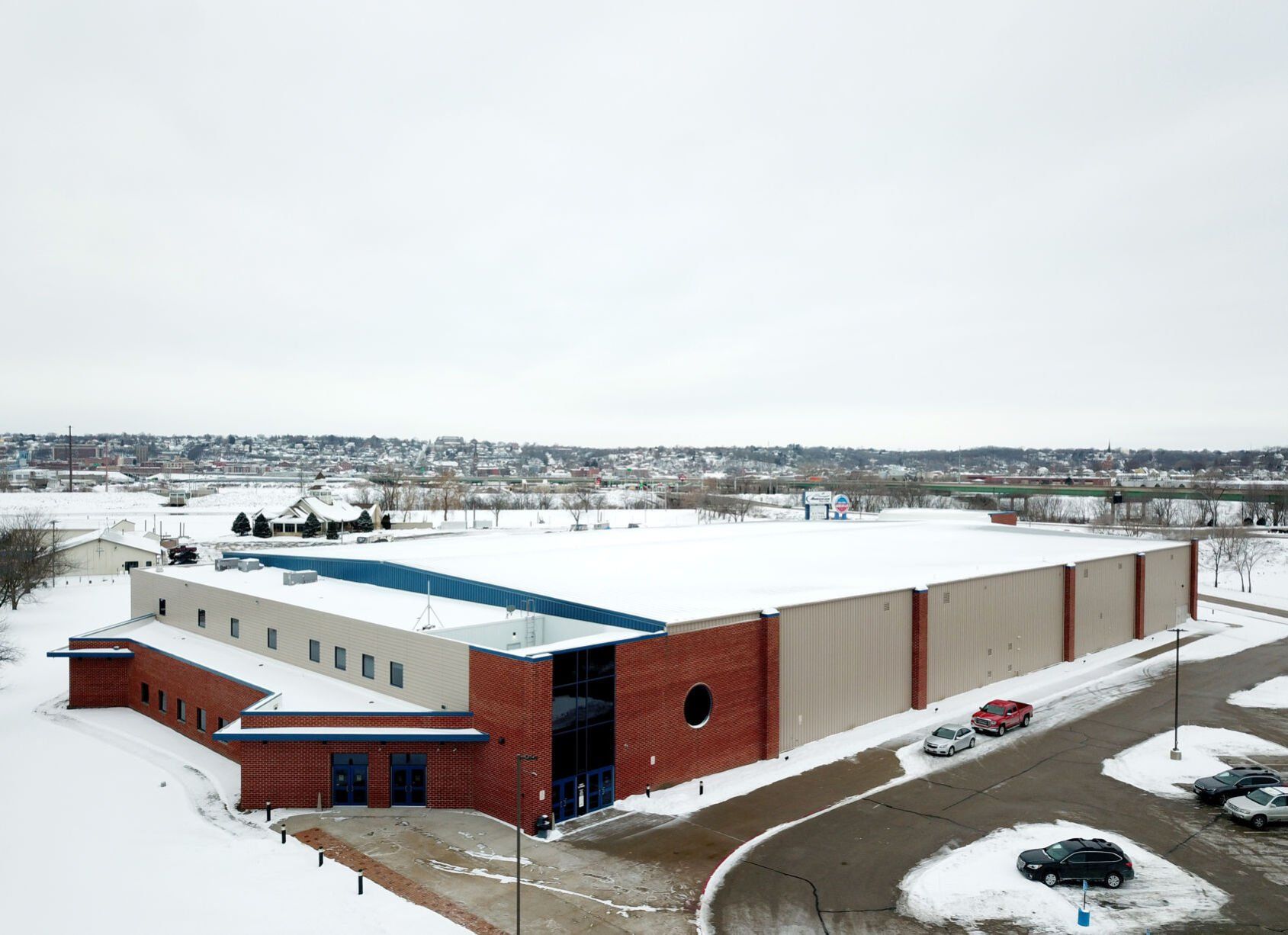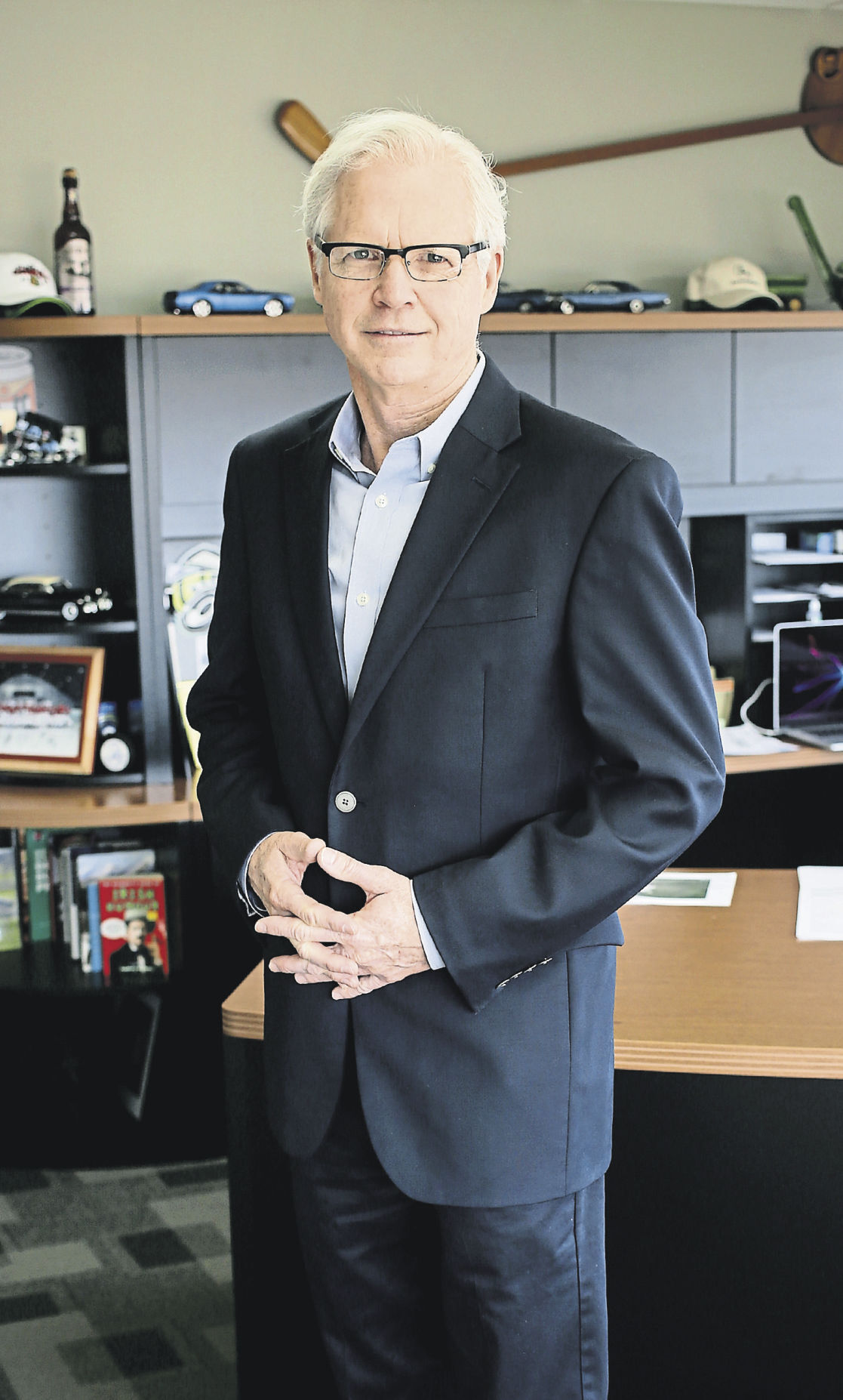In 2021, Dubuque’s Mystique Community Ice Center underwent a major shift that it had been skating toward for years.
The center’s management company, Dubuque Community Ice & Recreation Center Inc., announced in June that it would relinquish its management of the city-owned facility and disband as an organization.
It marked the end of an era for the ice center.
The nonprofit DICE was more than just its management company. The organization’s founding members, primarily made up of local residents passionate about hockey and figure skating, were the reason why the center came to exist. Since its opening 11 years earlier, DICE managed the facility to ensure that the original vision of the center was maintained.
For the community, the move was an unexpected turn in the story of the ice center, but the series of events that eventually led the nonprofit to give up the reins started as the center was being designed.
“If you knew this was going to happen, and you could do something differently, you would do it,” said Jack McCullough, a founding member of DICE. “I just hope whoever takes the center over keeps it a dedicated ice facility. Ice is first. Anything else is second.”
Now, city officials are working to find a new permanent manager of the facility while also dealing with both short-term and long-term costs for which it is now responsible.
The story of the ice arena
Prior to 2010, Mystique Community Ice Center was nothing more than the collective dream of a group of local hockey and figure skating enthusiasts.
In the 30 years leading up to the center’s construction, those in Dubuque wishing to utilize ice indoors had one option: Five Flags Center. When not hosting other events, the facility could house a temporary ice rink.
However, ice access at Five Flags proved inconsistent. The venue prioritized hosting events that proved most profitable, which meant that providing ice for skating and hockey regularly was pushed aside.
“It was really frustrating for parents at the time,” said Jim Goodman, a founding member of DICE. “With the Five Flags being a dual facility, you had to go and schedule around non-ice events. My son was on a traveling hockey team, and it was very challenging to ever schedule teams to come here.”
The combined frustrations of parents and community members were what eventually led to a group of them gathering in 2007 to start discussing another option.
Goodman said the original meetings of DICE were nothing more than a handful of hockey and skating enthusiasts gathering to discuss what a dedicated ice facility in Dubuque might look like. Goodman had served as president of Dubuque Youth Hockey Association, and his son was involved in local youth hockey.
“We first started meeting on my kitchen table, just talking about things,” he said. “We all knew we wanted to provide something for the community.”
Eventually, those discussions led to a plan for the construction of a small ice rink that would be entirely dedicated to supporting hockey and skating programming.
“We knew we had to have our own facility,” McCullough said. “You can’t grow a program in the kind of situation that we were in at the Five Flags.”
The initially envisioned ice center was much smaller than what it eventually came to be.
“We were looking at doing a smaller venue, maybe a 500-seat barn,” Goodman said. “Basically, just something that would be nice and you wouldn’t need a whole lot of people to run it.”
As planning for the center progressed and fundraising efforts were successful, the project started to draw the attention of the wider community and other organizations. They included officials with Northern Lights Hockey, which broached the idea of re-establishing the Dubuque Fighting Saints, the United States Hockey League team that had left the city in 2001.
“They basically said, ‘I hear you are putting a rink together in Dubuque. What would you think if you expanded it to 3,200 people because we have a junior team that would want to go back to Dubuque?’” Goodman recalled.
The Fighting Saints element dramatically increased the scope of the project. The 500-seat rink now needed to be a 3,200-seat arena, and the initial $3 million price tag for the project climbed to a little more than $7 million.
However, a larger venue created another complication: location.
Goodman said several sites had been identified for the smaller rink, including Veterans Memorial Park and Dubuque County Fairgrounds, but none of those were adequate for the larger building.
McCullough said it was then that the city, which was working with DICE on the project and also interested in bringing back the Fighting Saints, offered a parcel of land in the heart of Chaplain Schmitt Island.
“The city and the (Dubuque Racing Association) wanted it there because it was close to the casino,” McCullough said. “It was a staple for the island, and it was right off the highway. That made it a good location.”
A foundational issue
Last September and October, the City of Dubuque spent nearly $100,000 to have 12,000 pounds of foam injected under a floor slab at the center.
The foam was needed in order to fill structural voids under the building created by the compression of subsurface sediment over time. Assistant City Engineer Bob Schiesl explained that the issue related to the center’s site.
Prior to 1976, Chaplain Schmitt Island, then called City Island, was used as a landfill for nearly three decades. While the landfill was closed and the island subsequently was cleared for development, Schiesl said the years the island spent as a landfill created unfavorable soil conditions.
When the ice center was constructed, the building structure was built on a deep foundation system, while the lower-level main floor was built as an unsupported concrete slab.
While the foundation-supported section of the building has shown no signs of movement, a scan of the ice center by the city in November 2020 showed the portion supported by the concrete slab had lowered by more than 4 inches in some areas.
“The differential settlement has caused operational issues with the ice rink, rotational movement of the stadium bleachers, movement in the unsupported interior CMU walls and settlement of ice system mechanical equipment,” city documents state.
In the spring and summer of 2021, additional settlement of that slab was observed, leading ice center staff to temporarily limit occupancy in the northeast portion of the facility. A subsequent ground-penetrating-radar scan revealed additional subsurface sediment voids that could lead to portions of the building lowering farther.
“You essentially had this very heavy building compressing all that bad soil, and the result was some of the floors were bowing in the center,” Schiesl said. “It’s a problem that needed to be fixed.”
While the foam solution offered an immediate fix, Schiesl said the building likely will continue to compress the soil, and a more permanent, more expensive solution will be required.
City staff are in the midst of planning for a project to install a deep foundation system under the remainder of the facility. Schiesl said he expects the work will run from June to November and affect the availability at times of the center. The project likely will cost more than $2 million.
When DICE announced it was handing over the ice center to the city in 2021, then-DICE President Marvin Heiderscheit referenced the financial challenges presented by the organization’s lease agreement with the city. He has declined to identify the elements of the agreement that led to DICE relinquishing management of the facility.
However, McCullough said the move was prompted by the settling issues at the center and the lease agreement that put the cost of fixing it on DICE.
The agreement approved by DICE and City Council members in 2009 states the lessee of the property shall be responsible for paying for any repair at the center, “whether or not such repair shall be interior or exterior and whether or not such repair shall be of a structural nature.”
“Every expense was something that we needed to pay for, according to the agreement, and there is no way we could earn enough money to fix that,” McCullough said. “There was nothing we could do about it, so we have to turn over our rights to run the arena.”
McCullough explained that throughout DICE’s management, the ice center was not a lucrative venture and was kept afloat by volunteer work from DICE members who were passionate about the operations of the facility.
While the funds for operational expenses and general maintenance were raised and minor repairs were made throughout DICE’s tenure, the organization simply did not have the capital to repair the structural issues with the facility.
“We were hand-to-mouth for 11 years straight,” McCullough said. “We usually didn’t have any problems during the winter months, but the summer months were difficult.”
But the eventual structural settling was not a surprise to DICE members when it occurred. Both McCullough and Goodman said DICE and city officials were aware of the soil conditions prior to the center’s construction.
“Everyone knew this would become a problem,” McCullough said. “That is why we built part of the building on deep foundation.”
But not all of the facility was constructed that way.
When asked why recently by the Telegraph Herald, several city officials and former DICE members said they did not know why this decision was made, but both Goodman and McCullough said Mike Belmont, another founding member of DICE, was the designer of the building. A Telegraph Herald story covering the development of the ice center at the time named Belmont as the architect of the building as well.
Belmont currently works as the assistant housing director for the City of Dubuque. He previously worked as a principal for Larrison & Associates Architects.
When reached by the TH, Belmont said he did not design the building. He said he served as a computer-aided design manager for the building, while Larrison & Associates Architects served as the architect. While declining to take questions from the TH, Belmont provided one comment.
“There was, at the time, slab settlement that was expected,” he said. “The decision was made by all parties involved that we would remedy those as they came up.”
Greg Larrison is listed as the founder and principal architect of Larrison & Associates Architects on the company’s website. Larrison did not respond to emails asking for comment on this story, and the phone number to reach the Larrison office is not connected.
An uncertain future
When DICE relinquished its management of the ice center, the lease agreement required that the city offer management duties to the Dubuque Racing Association and, if that group declined, then to Northern Lights Hockey. Both organizations declined, leaving the city to assume management of the facility.
The city officially took over Mystique Community Ice Center on Sept. 6.
Leisure Services Manager Marie Ware said the intention was to ensure that the management transition from DICE to the city was seamless and did not interrupt any of the programming at the facility. Sarah Henkels, president of Dubuque Youth Hockey, said that is what happened.
“So far, we haven’t had any kinds of interruptions,” Henkels said. “We’ve been able to keep having practice, and the city has done a good job of keeping us informed.”
On the city’s end, the transition was not easy. Ware said taking on management of the center required significant extra work and hours by multiple city staff.
“This all has happened by a lot of people helping out in big ways,” Ware said.
From September to December, the city managed the facility and its employees. At the same time, Ware said, city staff were evaluating what organization could replace DICE and take over management of the ice center.
Ware previously had said that a new management organization might not be found until June, but in January, the Dubuque Racing Association approved an interim staffing agreement with the city to temporarily take over management duties of the facility. Under the agreement, which expires at the end of June, the DRA assumes management of the ice center’s employees, while the city will continue to pay for staffing expenses and oversee other aspects of maintaining the facility.
“The DRA will provide monthly its actual expenses for staffing the facility, and the city will reimburse the DRA for said expenses,” states a city document. “The agreement provides that the DRA has estimated the monthly expenses of $80,000. Only the direct employee expenses are included in the monthly expenses.”
The temporary agreement is seen by both city and DRA officials as the first step in negotiating a permanent agreement in which the DRA would completely manage the facility.
“It is the general consensus that we would like to do that,” said Kevin Lynch, chairman of the DRA’s executive committee. “Now, we can make sure it fits for the casino and the city.”
When asked why the DRA didn’t initially assume management under the original lease agreement, Lynch said that agreement was seen by DRA board members as too “restrictive,” specifically pointing to the expenses the DRA would have been responsible for under that agreement’s language.
Lynch and Ware said it remains undetermined how costs for maintaining the ice center will be distributed.
Ware told the TH that she is working on a budget to cover the center and its operations through the rest of the fiscal year, which ends at the end of June.
Since the city took over management in September, the facility has had $221,499 in revenue, while the city has spent $386,363, totaling a net loss of $164,864. Ware noted that part of those expenses included the purchase of a second ice resurfacer for $17,500, paying $125,000 to DICE for extending its oversight of the facility through December and purchasing extra supplies.
Meanwhile, city staff continue to evaluate the facility and assess future needs.
“We did the first settlement remediation project,” Ware told the TH via email. “This fall, we took care of a drainage issue in the parking lot area. We have planned to add a sidewalk from an exit door and the SW area of the center to the parking area. We are working on an assessment of the mechanical systems to better understand their current status and identify improvements that might be necessary. We have been researching equipment and potential improvements that would aid in efficient use of staff time and reduce operating costs. As one example, we have researched floor maintenance equipment that would reduce staff time spent on in that area. We have performed numerous smaller maintenance and repairs since taking the facility over.”
“Larger facilities like the ice center need daily care and repairs especially with the ice participants, guests and spectators during the busy season.”
Regardless of who manages the facility going forward, the former members of DICE are confident they won’t be involved, which for some of them raises concerns about the ice center’s future.
“DICE agreed to manage the arena because we wanted it to focus exclusively on ice,” Goodman said. “I can’t help but wonder now, is this going to be another Five Flags? Will certain non-ice events come in and bump out ice users?”
McCullough said a large motivation for DICE assuming management of the ice center and covering its expenses was to ensure that hockey and ice skating programming would be prioritized.
“We didn’t want it to be another Five Flags scenario,” he said. “The survival of youth hockey and figure skating, adult hockey — all of that — hinges on having committed ice.”






